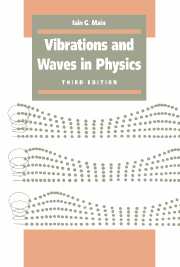Book contents
- Frontmatter
- Contents
- Preface to the first edition
- Preface to the second edition
- Preface to the third edition
- Notes for reference
- 1 Free vibrations
- 2 Free vibrations in physics
- 3 Damping
- 4 Damping in physics
- 5 Forced vibrations
- 6 Forced vibrations in physics
- 7 Anharmonic vibrations
- 8 Two-coordinate vibrations
- 9 Non-dispersive waves
- 10 Non-dispersive waves in physics
- 11 Fourier theory
- 12 Dispersion
- 13 Water waves
- 14 Electromagnetic waves
- 15 De Broglie waves
- 16 Solitary waves
- 17 Plane waves at boundaries
- 18 Diffraction
- Answers to problems and hints for solution
- Constants and units
- Index
18 - Diffraction
Published online by Cambridge University Press: 05 June 2012
- Frontmatter
- Contents
- Preface to the first edition
- Preface to the second edition
- Preface to the third edition
- Notes for reference
- 1 Free vibrations
- 2 Free vibrations in physics
- 3 Damping
- 4 Damping in physics
- 5 Forced vibrations
- 6 Forced vibrations in physics
- 7 Anharmonic vibrations
- 8 Two-coordinate vibrations
- 9 Non-dispersive waves
- 10 Non-dispersive waves in physics
- 11 Fourier theory
- 12 Dispersion
- 13 Water waves
- 14 Electromagnetic waves
- 15 De Broglie waves
- 16 Solitary waves
- 17 Plane waves at boundaries
- 18 Diffraction
- Answers to problems and hints for solution
- Constants and units
- Index
Summary
The boundaries between different wave-carrying media discussed in the previous chapter were assumed to be extensive. Reflected and refracted waves generated at such boundaries have a family resemblance to the incident wave giving rise to them; plane waves arriving at plane boundaries, for example, result in plane reflected and refracted waves.
If the second medium occupies only a small pocket of space embedded within the first medium, we think of it less as a medium and more as an object obstructing the progress of the wave through the medium proper. A new type of behaviour, known as diffraction, is apparent in such cases. Particularly striking effects are obtained when large numbers of identical diffracting objects are arranged in some regular way. A familiar example is provided by a street lamp as seen through a fog of water particles: the halo round the lamp would not be there if the lamp were viewed through a continuous mass of water.
The most characteristic feature of diffraction is that incident waves appear to ‘bend round’ objects made of materials which, in the form of extended media, are quite opaque. In a similar way, waves passing through a transparent hole in an opaque object are ‘spread out’. We shall refer to an obstacle in a transparent medium, or an aperture in an opaque object, as a diffraction centre.
We shall find that these effects are appreciable when the diffraction centres have dimensions which are comparable with the wavelength of the waves involved.
- Type
- Chapter
- Information
- Vibrations and Waves in Physics , pp. 320 - 342Publisher: Cambridge University PressPrint publication year: 1993



